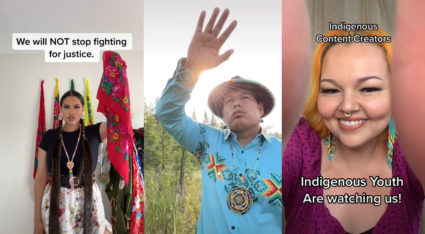
Authorities in California arrested the younger son of Rob and Michele Reiner after the couple was found dead this weekend.…

"Is that my cousin over there?" Brett Mooswa says in his most popular TikTok. "Let me wave at him and see if he notices."
The video cuts to a wave, which is promptly misinterpreted by someone who is not Native — also played by Mooswa — as a Native "blessing the land."
The post, which has been viewed more than 18 million times, is a sketch that pokes fun at how Native people are perceived.
@brettstoise Too majestic to be waving normally 😂 #nativehumor #indigenous #nativetiktok #nativeamerican
Though Mooswa, 30, lives by the mantra "laughter is good medicine," he also posts videos in his TikTok feed that addresses sobering issues like the harmful legacy of the Indian residential school system and the Missing and Murdered Indigenous Women, Girls and 2-Spirit People (MMIWG2S) movement.
He is part of a larger group of Indigenous content creators sharing their culture and advocating for justice on TikTok.
"As an Indigenous person, a lot of our stories are shunned and pushed into the background," said Mooswa, a member of the Plains Cree people. "I feel like it's very important to have our stories and our culture at the forefront."
TikTok can be an effective tool for social advocacy, said Jessie Loyer, a Cree-Métis librarian at Mount Royal University in Calgary, Canada. She studies information literacy, looking at the way Indigenous peoples create and consume information in digital spaces.
"Indigeous history is full of trauma, broken treaties, and genocide," Loyer said. "TikTok allows for people not to be drowned in that, but to receive the information in bite-sized pieces."
TikTok creator Michelle Chubb, a Swampy Cree content creator and model, echoed this, noting that the rapid-fire videos on TikTok allow for content to be consumed and spread quickly.
"Ever since the pandemic, a lot of people have joined TikTok. The videos are just right in your face and there's always videos coming up," she said. "It was a really good tool for me to start advocating because there are people out there wanting to help out and do the right thing."
Chubb's TikTok feed is a mix of fashion, makeup, humor and advocacy. Among her lighthearted videos showing off her jingle dress regalia or dancing to the latest trends, she takes time to educate her followers on issues important to her community, inviting them to research Indigenous causes and buy products from Indigenous-owned businesses. Her videos have amassed about 16 million likes on the app.
@indigenous_baddie The Indian Residential Schools Crisis Line is available 24-hours/day for anyone experiencing pain or distress – 1-866-925-4419
In May, TikTok's Canada branch released a statement of solidarity following the discovery of 215 bodies of Indigenous children at the Kamloops Indian Residential School. The branch then promised to make specific efforts to support Indigenous content creators on the video app, from developing initiatives highlighting Indigenous creators to pledging to donate 100,000 CA$ Canadian dollars to various Indigenous organizations.
There have been more than 3.4 billion views on the #NativeTikTok hashtag, as well as 605.5 million views on #IndigenousTikTok.
Sherry McKay, an Ojibwe tribe member from Winnipeg, Manitoba, has been making TikToks since June of 2019 for her audience of about 459,000 followers. McKay was a part of TikTok's "Creator Circle," an event showcasing Indigenous creators. She was also highlighted as one of the "top Canadian creators" during Indigenous History Month.
McKay's feed is full of humor, videos about being a parent, clips debunking myths about Indigenous people and educating viewers on Indigenous history. In early 2021, she began making "Sherry's Friend Mail Friday" videos where she opens packages sent by her fans.
"I started creating content, not necessarily to be recognized, but to spark something in people. To pass the torch," said McKay, reflecting on the outpouring of support she has received from viewers.
Chubb echoed this, saying the best thing to come out of her content creation is becoming a role model for Indigenous youth.
"When I was younger I didn't have many people to look up to," Chubb said, noting a lack of accurate Indigenous representation in the media.
"We have tons of examples of terrible representations," Loyer said, specifically highlighting sports teams that use Indigenous names, people and stereotypes as mascots. Loyer said this is one of the reasons Indigenous people producing their own culturally-accurate TikTok content is important for representation.
"The more that we get to see these little pockets of the world, aren't we all better for it?" she added.
@sherry.mckay We must protect our youth. Block out the noise so we can Rise up. Block/Delete distractions. ❤️❤️
Chubb, McKay and Mooswa all said they've received racist comments on their videos, too, though Chubb said viewers often defend her against racism that crops up in her comment section. But the creators also noted messages of support.
All three creators told the NewsHour that they've heard from their audiences that they helped Indigenous viewers feel more confident in themselves and proud of their heritage — and has even inspired some viewers to begin making their own videos.
Mooswa noted that seeing other Indigenous creators was what originally inspired him to make content in February 2020. In the beginning, he saw how videos from McKay and Andrew Bird, a TikTok creator who makes videos reminding his audience to relax and be grateful, were making an impact on the platform.
"I thought: 'If they can do it, I can too,'" he said.
Sustain our coverage of culture, arts and literature.